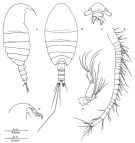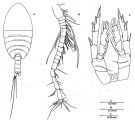|
|
 |
Fiche d'espèce de Copépode |
|
|
Calanoida ( Ordre ) |
|
|
|
Epacteriscoidea ( Superfamille ) |
|
|
|
Epacteriscidae ( Famille ) |
|
|
|
Epacteriscus ( Genre ) |
|
|
| |
Epacteriscus rapax Fosshagen, 1973 (F,M) | |
| | | | | | | Ref.: | | | Fosshagen, 1973 (p.146, figs.F,M); Huys & Boxshall, 1991 (p.52, 70, 80, figs.F); Fosshagen & al., 2001 (p.276, 316, Rem.); Boxshall & Halsey, 2004 (p.113: figs.F) |  issued from : A. Fosshagen in Sarsia, 1973, 52. [p.148, Fig.1]. Female (from N of Key Largo, Florida): A, habitus (lateral right side); B, idem (dorsal); C, forehead with rostrum, labrum and distal part of mandibular blade (ventral view); D, idem (lateral right side); E, A1; F, A2. Nota: Rostrum broad, consists of 2 rounded, down-turned plates with a cleft in between, each plate with 1 filament. A1 24-segmented ( well furnished with setae and aesthetascs), extending backwards to the last segment of the prosome. Exopod of A2 5-segmented, endopod 2-segmented. Urosome 3-segmented. Genital segment with genital openings set close together. Furcal rami with 5 plumose setae (the outermost small), both 2nd and 3rd setae jointed near their bases.
|
 issued from : A. Fosshagen in Sarsia, 1973, 52. [p.149, Fig.2]. Female: A, Md; B, Mx1; C, Mx2; D, Mxp; E, P1; F, P2; G, P3; H, P4; I, P5. Nota: Mx1 has few setae and weakly developed lobes: 1st lobe with 4 small setae, and the outer one 3 long setae; the terminal part (exopod?) with 4 long setae. Mx2: 1st segment bears a small lobe with 3 setae, 1 single seta, 3 setae in a group, and finally 2 large setae close together; the rest of the limb with at its tip several spinous setae. Md unique among calanoids; palp small, exopod with 4 setae, no endopod; the cutting blade has a prominent extension bearing sharp teeth, this serrated process extends out from the body and seems to serve as one arm of a pair of forceps for catching prey. Closer to the body on the cutting blade itself there are 2 sharp teeth and a broad toothed process (which resemble the usual type of cutting edge of a calanoid, and which probably function in the same way). The following pecularities distinguish the endopods of P2-P4 from those of other calanoids: the outer margin of the 1st segment bears a pointed process in its middle; the two setae along the outer margin of the last segment are each inserted in a deep indentation; distally to both the process and the two setae the margin is finely serrated; the outer margin of the basipod of P4 and P5 bears a long seta.
|
 issued from : A. Fosshagen in Sarsia, 1973, 52. [p.151, Fig.3]. Male: A, habitus (dorsal); B, right A1; C, P5 (posterior view). Nota: Right A1 17-segmented, geniculation between segments 13 and 14. Except A1, the other cephalic appendages and the first four legs cannot be distinguished from those of the female.
| | | | | NZ: | 1 | | |
|
Carte de distribution de Epacteriscus rapax par zones géographiques
|
| | | | Loc: | | | Florida (Broad Creek), Bermuda (Cherry Pit cave), Colombia (Punta de Betin) | | | | N: | 2 | | | | Lg.: | | | (383) F: 0,74; 0,73; M: 0,63; {F: 0,73-0,74; M: 0,63} | | | | Rem.: | epibenthique (Fonds: 1-4 m), parmi les coraux.
La gnathobase de Md présente une forme originale, unique parmi les calanoïdes. Espèce prédatrice au vue de la structure de Md et des soies épineuses courtes et fortes à la partie distale de Mx2 (fonction assumée généralement par le développement du 1er lobe interne et de ses fortes soies de Mx1).
Voir aussi les remarques en anglais | | | Dernière mise à jour : 03/01/2015 | |
|
|
 Toute utilisation de ce site pour une publication sera mentionnée avec la référence suivante : Toute utilisation de ce site pour une publication sera mentionnée avec la référence suivante :
Razouls C., Desreumaux N., Kouwenberg J. et de Bovée F., 2005-2025. - Biodiversité des Copépodes planctoniques marins (morphologie, répartition géographique et données biologiques). Sorbonne Université, CNRS. Disponible sur http://copepodes.obs-banyuls.fr [Accédé le 21 octobre 2025] © copyright 2005-2025 Sorbonne Université, CNRS
|
|
 |
 |






